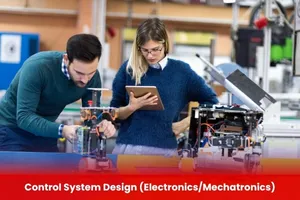Control System Design (Electronics/Mechatronics)
Burraq UK offers comprehensive training programs in Control System Design, focusing on Mechatronics and Electronics disciplines. These programs are designed to equip students and professionals with the practical skills and theoretical knowledge required to excel in the field of industrial automation and control systems.

Aim of Control System Design (Electronics/Mechatronics)
The aim of this course is to provide students and professionals with a strong foundation in the principles and practical applications of control system design, specifically within the fields of Electronics and Mechatronics. It focuses on equipping learners with the skills required to design, simulate, and implement control systems used in industrial automation and modern engineering systems.
Course Overview
Control System Design (Electronics/Mechatronics)
Educational Background
Applicants should have one of the following:
- Diploma (DAE) in:
- Electrical Engineering
- Electronics
- Mechatronics
- Instrumentation
- Bachelor’s Degree (BSc / B.E / B.Tech) in:
- Electrical Engineering
- Electronics Engineering
- Mechatronics Engineering
- Computer Engineering (with automation focus)
- Master’s Degree holders in the above fields are also eligible for advanced-level modules.
Technical Knowledge (Preferred but not mandatory)
- Basic understanding of:
- Electrical and electronic components
- Logic gates and circuits
- Sensors and actuators
- Programming basics (ladder logic, structured text, etc.)
| Course Code | Curriculum Title | Credit | DLH |
|---|---|---|---|
| BUK1393-1 | Introduction to Control Systems | 3 | 15 |
| BUK1393-2 | System Modeling and Simulation | 3 | 15 |
| BUK1393-3 | Sensors and Actuators | 3 | 15 |
| BUK1393-4 | PLC (Programmable Logic Controller) | 3 | 15 |
| BUK1393-5 | HMI (Human Machine Interface) | 3 | 15 |
| BUK1393-6 | SCADA Systems | 3 | 15 |
Learning Objectives
- Introduction to Control Systems
- Open-loop vs. closed-loop systems
- Types of control systems: Linear, non-linear, digital, analog
- Block diagram representation
- Transfer functions and system modeling
- System Modeling and Simulation
- Mechanical, electrical, and electromechanical system modeling
- Time and frequency domain analysis
- MATLAB/Simulink basics
- Response analysis (step, impulse, ramp)
- Sensors and Actuators
- Types of sensors: Proximity, temperature, pressure, optical
- Types of actuators: Motors (DC, stepper, servo), solenoids, relays
- Sensor-actuator integration
- Signal conditioning
- PLC (Programmable Logic Controller)
- PLC architecture and hardware
- Digital and analog I/O
- Ladder Logic programming
- Timer, counter, and comparison functions
- PLC simulation using TIA Portal / LOGO Soft Comfort
- HMI (Human Machine Interface)
- Introduction to HMI screens
- Designing user interfaces
- Data visualization and control
- Linking PLC and HMI
- SCADA Systems
- Introduction to SCADA
- SCADA vs. HMI
- Real-time monitoring and control
- Alarms, trends, and data logging
- Communication protocols (Modbus, OPC, etc.)
- Feedback and Control Algorithms
- Proportional (P), Integral (I), Derivative (D) control
- Tuning of PID controllers
- Practical PID applications
- Stability and performance criteria
- Electrical Drives & Motor Control
- Motor types (AC/DC, stepper, servo)
- Drive configuration and control
- Variable Frequency Drives (VFD)
- Motor start/stop logic with PLC
- Industrial Communication Protocols
- RS-232, RS-485
- Modbus RTU/TCP
- Ethernet/IP
- CAN, Profibus (overview)
- Engineering Students
- Engineering Graduates
- Working Professionals
- Technicians & Field Engineers
- Career Switchers / Freelancers
- Hobbyists & DIY Enthusiasts
- All Modules within this qualification are assessed internally by the approved training Centre and externally verified by BURRAQ UK. The program uses a criterion-referenced assessment approach to ensure that learners successfully meet all required learning outcomes.
- A Pass in any unit is granted only when the learner submits valid, reliable, and authentic evidence that demonstrates achievement of the assessment criteria. The Assessor is responsible for reviewing this evidence and confirming that the learner has attained the expected standard.
